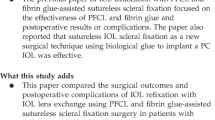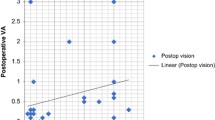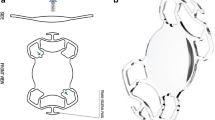Summary
Introduction: Accurate positioning of transsclerally fixated intraocular lenses in vitrectomized eyes is difficult to achieve because of the lack of stability of the globe. External stabilization with a Flieringa device is widely used. Internal stabilization, however, with liquid perfluorocarbon seems to be more advantageous.
Methods: Endostabilization with perfluorocarbon after pars plana vitrectomy prior to transscleral fixation of a posterior chamber lens was performed in 18 eyes. The intraocular lens floats on the surface of the perfluorocarbon. The level of the liquid can be adjusted to position the lens accurately. Transscleral fixation of the intraocular lens was followed by silicone oil injection in 4 eyes and by BSS injection in 14 eyes.
Results and conclusions: Endostabilization of the globe with liquid perfluorocarbon serves as a diaphragm preventing hemorrhage into the vitreous cavity and sliding of the intraocular lens, thus permitting proper positioning. There were no complications either intraoperatively, or postoperatively. Perfluorocarbon is a considerable aid in facilitating the positioning of a transsclerally fixated intraocular lens.
Zusammenfassung
Hintergrund: Die Positionierung einer sklerafixierten Hinterkammerlinse im vitrektomierten Auge stellt wegen der mangelnden Stabilität des Bulbus ein chirurgisches Problem dar. Es wird häufig mit Hilfe eines Flieringa-Ringes zu lösen versucht, Perfluorkarbon scheint demgegenüber aber Vorteile zu bieten.
Patienten und Methode: In 18 Fällen wurde im Rahmen netzhautchirurgischer Eingriffe eine Sklerafixation unter Endostabilisation mit Perfluorkarbon vorgenommen. Nach Eingabe des Perfluorkarbons über die Pars plana konnte die Hinterkammerlinse über einen skleralen Tunnelschnitt implantiert werden. Kontrollierte Veränderungen des Perfluorkarbonspiegels ermöglichten die gewünschte Positionierung der Linse. Nach Einnähen der Linse wurde das Perfluorkarbon in 4 Fällen durch Silikonöl, in 14 Fällen durch BSS ersetzt.
Ergebnisse: Die Endostabilisation mit Perfluorkarbon wirkt intraoperativ als Diaphragma, welches Einblutungen in den intravitrealen Raum oder ein Abrutschen der Linse verhindert. Intraoperative Komplikationen können minimiert werden.
Schlußfolgerung: Perfluorkarbon ist zur endobulbären Stabilisation eine hilfreiche operative Alternative bei der Sklerafixation von Hinterkammerlinsen im vitrektomierten Auge.
Similar content being viewed by others
Author information
Authors and Affiliations
Rights and permissions
About this article
Cite this article
Schmitz, P., Hermeking, H. & Gerke, E. Liquid perfluorocarbon for transscleral fixation of posterior chamber lenses. Ophthalmologe 95, 564–567 (1998). https://doi.org/10.1007/s003470050317
Published:
Issue Date:
DOI: https://doi.org/10.1007/s003470050317




